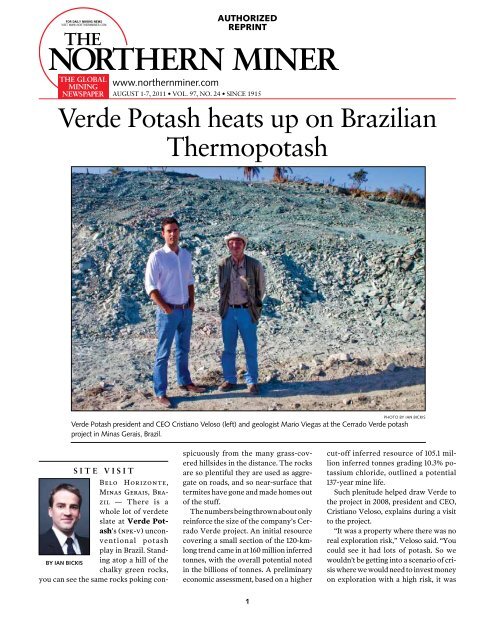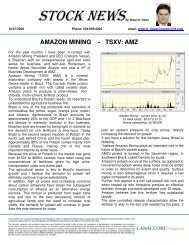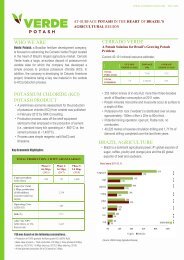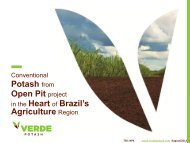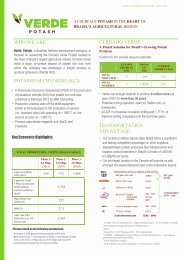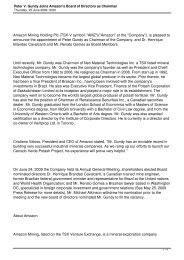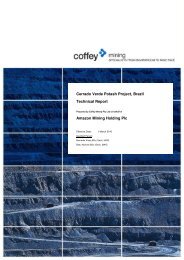Verde Potash heats up on Brazilian thermopotash - Ahead of the Herd
Verde Potash heats up on Brazilian thermopotash - Ahead of the Herd
Verde Potash heats up on Brazilian thermopotash - Ahead of the Herd
You also want an ePaper? Increase the reach of your titles
YUMPU automatically turns print PDFs into web optimized ePapers that Google loves.
AUTHORIZEDREPRINTwww.nor<strong>the</strong>rnminer.comAugust 1-7, 2011 • VOL. 97, NO. 24 • SINCE 1915<str<strong>on</strong>g>Verde</str<strong>on</strong>g> <str<strong>on</strong>g>Potash</str<strong>on</strong>g> <str<strong>on</strong>g>heats</str<strong>on</strong>g> <str<strong>on</strong>g>up</str<strong>on</strong>g> <strong>on</strong> <strong>Brazilian</strong>ThermopotashPhoto by Ian Bickis<str<strong>on</strong>g>Verde</str<strong>on</strong>g> <str<strong>on</strong>g>Potash</str<strong>on</strong>g> president and CEO Cristiano Veloso (left) and geologist Mario Viegas at <strong>the</strong> Cerrado <str<strong>on</strong>g>Verde</str<strong>on</strong>g> potashproject in Minas Gerais, Brazil.S i t e V i s i tBelo Horiz<strong>on</strong>te,Minas Gerais, Brazil— There is awhole lot <strong>of</strong> verdeteslate at <str<strong>on</strong>g>Verde</str<strong>on</strong>g> <str<strong>on</strong>g>Potash</str<strong>on</strong>g>’s(npk-v) unc<strong>on</strong>venti<strong>on</strong>alpotashplay in Brazil. Standingatop a hill <strong>of</strong> <strong>the</strong>By ian bickischalky green rocks,you can see <strong>the</strong> same rocks poking c<strong>on</strong>spicuouslyfrom <strong>the</strong> many grass-coveredhillsides in <strong>the</strong> distance. The rocksare so plentiful <strong>the</strong>y are used as aggregate<strong>on</strong> roads, and so near-surface thattermites have g<strong>on</strong>e and made homes out<strong>of</strong> <strong>the</strong> stuff.The numbers being thrown about <strong>on</strong>lyreinforce <strong>the</strong> size <strong>of</strong> <strong>the</strong> company’s Cerrado<str<strong>on</strong>g>Verde</str<strong>on</strong>g> project. An initial resourcecovering a small secti<strong>on</strong> <strong>of</strong> <strong>the</strong> 120-kml<strong>on</strong>gtrend came in at 160 milli<strong>on</strong> inferredt<strong>on</strong>nes, with <strong>the</strong> overall potential notedin <strong>the</strong> billi<strong>on</strong>s <strong>of</strong> t<strong>on</strong>nes. A preliminaryec<strong>on</strong>omic assessment, based <strong>on</strong> a highercut-<strong>of</strong>f inferred resource <strong>of</strong> 105.1 milli<strong>on</strong>inferred t<strong>on</strong>nes grading 10.3% potassiumchloride, outlined a potential137-year mine life.Such plenitude helped draw <str<strong>on</strong>g>Verde</str<strong>on</strong>g> to<strong>the</strong> project in 2008, president and CEO,Cristiano Veloso, explains during a visitto <strong>the</strong> project.“It was a property where <strong>the</strong>re was noreal explorati<strong>on</strong> risk,” Veloso said. “Youcould see it had lots <strong>of</strong> potash. So wewouldn’t be getting into a scenario <strong>of</strong> crisiswhere we would need to invest m<strong>on</strong>ey<strong>on</strong> explorati<strong>on</strong> with a high risk, it was1
AUTHORIZEDREPRINTwww.nor<strong>the</strong>rnminer.comAugust 1-7, 2011 • VOL. 97, NO. 24 • SINCE 1915more market development.”The company needed to develop a marketbecause, while this plentiful resourcehas been known since <strong>the</strong> 1960s, no <strong>on</strong>ehas actually managed to sell any <strong>of</strong> it.But <str<strong>on</strong>g>Verde</str<strong>on</strong>g> hopes to change that bytransforming <strong>the</strong> o<strong>the</strong>rwise useless glauc<strong>on</strong>ite-basedrocks into potentiallyvaluable “Thermopotash.” Decades ago,Vale (vale-n) looked into <strong>the</strong> potassium-richrocks at Cerrado <str<strong>on</strong>g>Verde</str<strong>on</strong>g> as apotential source <strong>of</strong> fertilizer, and found itcould create a potash alternative by cooking<strong>the</strong> rocks at high temperatures, andadding limest<strong>on</strong>e. In this way, Thermopotashwas born.The product has a lower potassiumoxide grade than more c<strong>on</strong>venti<strong>on</strong>al potash,but it is alsolow-chlorine, requiresfarmers use less limest<strong>on</strong>e <strong>on</strong> <strong>the</strong>ir fields,and its low solubility means <strong>the</strong> nutrientsare released slowly and not washedaway by Brazil’s heavy rains.But <strong>the</strong> cost <strong>of</strong> roasting <strong>the</strong> verdete over1,000°C was high, and local demand wasrelatively low, so Vale aband<strong>on</strong>ed <strong>the</strong>project and let <strong>the</strong> claims lapse.The situati<strong>on</strong>s in Brazil and <strong>the</strong> potashmarket have since changed dramatically.The agricultural sector has exploded, andfertilizer prices have followed suit. And<strong>the</strong>re, in <strong>the</strong> middle <strong>of</strong> this boom, sits<str<strong>on</strong>g>Verde</str<strong>on</strong>g> <str<strong>on</strong>g>Potash</str<strong>on</strong>g> and its sizable resource,waiting to reap <strong>the</strong> benefits <strong>of</strong> a welltimedland play.A PEA and market studies c<strong>on</strong>firm that<str<strong>on</strong>g>Verde</str<strong>on</strong>g> could make a respectable pr<strong>of</strong>itfrom Thermopotash. A sec<strong>on</strong>d technologicalbreakthrough — currently in <strong>the</strong>works, and patent-pending — couldradically change <strong>the</strong> company’s fortunes.Humble beginnings<str<strong>on</strong>g>Verde</str<strong>on</strong>g> <str<strong>on</strong>g>Potash</str<strong>on</strong>g>, which recently changed itsname from Amaz<strong>on</strong> Mining, did not beginas a potash company.When Veloso started <strong>the</strong> company in2005, he was intent <strong>on</strong> finding far morealluring gold. A native <strong>of</strong> Brazil’s miningcapital Belo Horiz<strong>on</strong>te, he was familiarwith <strong>the</strong> country’s <strong>on</strong>e-time status as <strong>the</strong>world’s largest exporter <strong>of</strong> gold (albeit in<strong>the</strong> 18th century), and wanted to make<strong>the</strong> most <strong>of</strong> his local experience to advanceprojects.His experiences as a 24-year-old,however, were somewhat limited. Butfresh from completing an advanced degreein internati<strong>on</strong>al business law, followingtwo earlier degrees, Veloso ga<strong>the</strong>redseed capital for <strong>the</strong> private venture, andwas ready to spread his entrepreneurialroots.“I’ve always been a bit <strong>of</strong> an entrepreneur,”Veloso says, recounting how heended <str<strong>on</strong>g>up</str<strong>on</strong>g> running a mining company atan age when most are trying to get hiredby <strong>on</strong>e. “Mining was a part <strong>of</strong> my lifegrowing <str<strong>on</strong>g>up</str<strong>on</strong>g>, and it just came as naturalwhen I started.”The company found limited successwith early properties, but debuted <strong>on</strong> <strong>the</strong>TSX Venture Exchange with a $16-milli<strong>on</strong>initial public <strong>of</strong>fering at $1.20 in late2007. A year later, <strong>the</strong> company tradedat barely 20¢, and change was afoot.Lured by a steep increase in potashprices, which in Brazil peaked at aroundUS$1,000 a t<strong>on</strong>ne in 2008, Veloso led<strong>the</strong> company out <strong>of</strong> gold and into potash.He encountered str<strong>on</strong>g resistance, butwith <strong>the</strong> company having already aband<strong>on</strong>edthree gold projects in 2008, Velos<strong>of</strong>ought for <strong>the</strong> change in directi<strong>on</strong>,and w<strong>on</strong>. So <strong>the</strong> team got to work.“When potash prices started going <str<strong>on</strong>g>up</str<strong>on</strong>g>,”Veloso says, “we sat down with our explorati<strong>on</strong>team, and we carefully lookedat every single opportunity <strong>on</strong> potash inBrazil.”Veloso said <strong>the</strong> team found envir<strong>on</strong>mentaland social problems with <strong>the</strong> obviouspotash prospects in <strong>the</strong> Amaz<strong>on</strong>Basin, and obstacles for properties surroundingVale’s Taquari-Vassourasmine in Sergipe state, <strong>the</strong> <strong>on</strong>ly active potassiummine in Brazil.The most interesting project turnedout to be a potassium silicate propertythat Ysao Munemassa, <str<strong>on</strong>g>Verde</str<strong>on</strong>g>’s currentexplorati<strong>on</strong> manager, had worked <strong>on</strong>with Vale l<strong>on</strong>g ago. Munemassa pointed<str<strong>on</strong>g>Verde</str<strong>on</strong>g> to <strong>the</strong> property’s still unrealizedpotential, and helped identify <strong>the</strong> bestground. In return, he got a 3% royalty <strong>on</strong><strong>the</strong> property, which <str<strong>on</strong>g>Verde</str<strong>on</strong>g> can buy for$3 milli<strong>on</strong> at any time.<str<strong>on</strong>g>Verde</str<strong>on</strong>g> went <strong>on</strong> a staking rush to secureas much choice land as possible, evenclaiming some areas as diam<strong>on</strong>d andphosphate licenses to avoid suspici<strong>on</strong>.The efforts proved wise. Vale swoopedin shortly after, and staked a large landpackage adjacent to <str<strong>on</strong>g>Verde</str<strong>on</strong>g>.On Nov. 24, 2008, <str<strong>on</strong>g>Verde</str<strong>on</strong>g> announced ithad amassed a 1,650-sq.-km land packagethat represented a “major <strong>Brazilian</strong> potashopportunity,” and a new directi<strong>on</strong> for<strong>the</strong> company. Shortly after, <strong>the</strong> company’sshare price hit an all-time low <strong>of</strong> 7¢.Out <strong>of</strong> NecessityThe next year was <strong>on</strong>e <strong>of</strong> patience.<str<strong>on</strong>g>Verde</str<strong>on</strong>g> worked to prove <str<strong>on</strong>g>up</str<strong>on</strong>g> a resource, andprove to investors that verdete slate —and <strong>the</strong> Thermopotash made from it —were indeed worthwhile commodities.The company amassed a who’s who <strong>of</strong>research and development partners. The<strong>Brazilian</strong> government-sp<strong>on</strong>sored Centrefor Mineral Technology signed <strong>on</strong>, as did<strong>the</strong> research program Agrominerais. Embrapa,Brazil’s main agricultural researchcorporati<strong>on</strong>, <strong>the</strong> University <strong>of</strong>Uberlandia, and <strong>the</strong> University <strong>of</strong> Lavraswould also all eventually research <strong>the</strong>practicability <strong>of</strong> Thermopotash.The government <strong>of</strong> Minas Gerais,meanwhile, fully endorsed <strong>the</strong> idea, andpromised preferential tax treatment,s<str<strong>on</strong>g>up</str<strong>on</strong>g>port in financing <strong>the</strong> project and helpwith <strong>the</strong> approval process.Later in 2009, ArcelorMittal (mt-n)signed <str<strong>on</strong>g>up</str<strong>on</strong>g> to test Thermopotash, as wouldAgrifirma Brazil, a UK-based agriculturefirm, while Sekita Agr<strong>on</strong>egocios, a leading<strong>Brazilian</strong> agribusiness, signed <strong>on</strong> in2
AUTHORIZEDREPRINTwww.nor<strong>the</strong>rnminer.comAugust 1-7, 2011 • VOL. 97, NO. 24 • SINCE 1915Grazing at <str<strong>on</strong>g>Verde</str<strong>on</strong>g> <str<strong>on</strong>g>Potash</str<strong>on</strong>g>’s Cerrado <str<strong>on</strong>g>Verde</str<strong>on</strong>g> potash project in Brazil.Photo by Ian Bickisearly 2010. Sekita, a major vegetablegrowerin <strong>the</strong> country, planned to test<strong>the</strong> product in “real world c<strong>on</strong>diti<strong>on</strong>s,”which led to ra<strong>the</strong>r unwelcome results.The pedigree <strong>of</strong> parties interested in<str<strong>on</strong>g>Verde</str<strong>on</strong>g>’s science project was a testamentto <strong>the</strong>ir curiosity in <strong>the</strong> product and, ina way, <strong>the</strong>ir desperati<strong>on</strong>. Brazil hasquickly become <strong>on</strong>e <strong>of</strong> <strong>the</strong> world’s leadingc<strong>on</strong>sumers <strong>of</strong> fertilizers, importingover 90% <strong>of</strong> its potash. The country isexpected to be <strong>the</strong> world’s largest potashimporter by 2020.The demand has been sparked by <strong>the</strong>agricultural revoluti<strong>on</strong> <strong>of</strong> <strong>the</strong> Cerrado.Thanks to early research by Embrapa, anda healthy dose <strong>of</strong> limest<strong>on</strong>e and fertilizer,<strong>the</strong> <strong>on</strong>ce-barren expanse has been transformedinto <strong>on</strong>e <strong>of</strong> <strong>the</strong> world’s greatagricultural regi<strong>on</strong>s.The country is now <strong>the</strong> world’s largestexporter <strong>of</strong> c<strong>of</strong>fee, sugar cane and ethanol,to name a few, which comes as nosurprise after seeing endless lush greenfields filled with cash crops <strong>on</strong> a driveacross Minas Gerais. Veloso has witnessed<strong>the</strong> transiti<strong>on</strong> first-hand.“Back in <strong>the</strong> seventies and eighties . . .<strong>the</strong>re was nothing, <strong>the</strong>y couldn’t growanything in <strong>the</strong> Cerrado regi<strong>on</strong> <strong>of</strong> Brazil.It was a very different scenario to whatit is today,” Veloso says.Brazil’s agricultural industry has littlestopping it from growing much bigger.The country has <strong>the</strong> world’s largeststores <strong>of</strong> renewable fresh water, a dynamicand educated workforce, a climatethat allows <str<strong>on</strong>g>up</str<strong>on</strong>g> to three growing cycles ayear and, thanks to <strong>the</strong> Cerrado, by far<strong>the</strong> most potential new arable land in <strong>the</strong>world.All Brazil lacks is fertilizer.Milest<strong>on</strong>es<str<strong>on</strong>g>Verde</str<strong>on</strong>g> is proposing to help fill <strong>the</strong> fertilizergap by using Thermopotash as a 15%blend in existing nitrogen-phosphoruspotassiumblends, or NPK blends. Twosignificant studies help validate its plan.A market study that looked at potentialpricing <strong>of</strong> <strong>the</strong> Thermopotash estimateda price in Minas Gerais <strong>of</strong> US$182.31per t<strong>on</strong>ne, or US$160.04 delivered, whilewith delivery to o<strong>the</strong>r states, <strong>the</strong> adjustedprice ranged from US$63.68 toUS$130.13 per t<strong>on</strong>ne. Minas Gerais hadan estimated market <strong>of</strong> 896,000 t<strong>on</strong>nes,while <strong>the</strong> total market potential was 4.4milli<strong>on</strong> t<strong>on</strong>nes at a weighted averageprice <strong>of</strong> US$112.82 delivered.Delivery costs are high because Brazilhas a serious infrastructure deficit. Mostfreight moves around <strong>the</strong> country bytrucks, as was evident by <strong>the</strong> two-lane3
AUTHORIZEDREPRINTwww.nor<strong>the</strong>rnminer.comAugust 1-7, 2011 • VOL. 97, NO. 24 • SINCE 1915highways clogged with <strong>the</strong> slow-movingmachines.Transportati<strong>on</strong> is also a key part <strong>of</strong><str<strong>on</strong>g>Verde</str<strong>on</strong>g>’s competitive edge compared withimports. Veloso explains that, when localblenders order potash from Saskatchewan,<strong>the</strong>y must wait three m<strong>on</strong>ths for <strong>the</strong>ship to arrive, <str<strong>on</strong>g>up</str<strong>on</strong>g> to a m<strong>on</strong>th more to unload<strong>the</strong> cargo in Brazil’s severely c<strong>on</strong>gestedports, and <strong>the</strong>n haul it by truckanywhere from 600 to 1,000 km inland.Total transportati<strong>on</strong> costs for importsrun from $150 to $200 per t<strong>on</strong>ne, while<str<strong>on</strong>g>Verde</str<strong>on</strong>g> is looking at $20 to $70 per t<strong>on</strong>ne.“Literally being down <strong>the</strong> road fromwhere <strong>the</strong> blenders are in Brazil, immediatelydown <strong>the</strong> road from <strong>the</strong> biggestblending district in Brazil, it just makesit a very simple propositi<strong>on</strong>,” Veloso says.<str<strong>on</strong>g>Verde</str<strong>on</strong>g>’s capital costs also set it apartfrom most potash projects, which <strong>of</strong>tenrun into <strong>the</strong> billi<strong>on</strong>s. A PEA released lastfall estimates capital costs <strong>of</strong> US$196.8milli<strong>on</strong> for a 1.1-milli<strong>on</strong> t<strong>on</strong>ne a year operati<strong>on</strong>,and US$269.4 milli<strong>on</strong> for double<strong>the</strong> output.For <strong>the</strong> smaller, base-case model, operatingcosts are estimated at US$41.80per t<strong>on</strong>ne, with a capital payback in 2.4years. The scenario generates a net presentvalue (NPV) <strong>of</strong> US$455.4 milli<strong>on</strong> ata 10% discount rate, and an after-taxinternal rate <strong>of</strong> return (IRR) <strong>of</strong> 32.9%.A doubled 2.2-milli<strong>on</strong>-t<strong>on</strong>ne opti<strong>on</strong>cuts operating costs by US$5.44 pert<strong>on</strong>ne, payback by half a year, andboosts <strong>the</strong> NPV to US$858.1 milli<strong>on</strong>,and <strong>the</strong> IRR to 40.2%.Veloso says <strong>the</strong> PEA, al<strong>on</strong>g with <strong>the</strong>marketing study, have g<strong>on</strong>e a l<strong>on</strong>g wayin validating <strong>the</strong> Cerrado <str<strong>on</strong>g>Verde</str<strong>on</strong>g> story.“We had big expectati<strong>on</strong>s that itcould be a success, but those were <strong>the</strong>two independent milest<strong>on</strong>es that helpedc<strong>on</strong>firm it,” Veloso says.Down to <strong>the</strong> detailsWith <strong>the</strong> basics established, <str<strong>on</strong>g>Verde</str<strong>on</strong>g> is nowperfecting <strong>the</strong> processing, and provingit’s possible <strong>on</strong> a large scale.For <strong>the</strong> roasting, <str<strong>on</strong>g>Verde</str<strong>on</strong>g> initially c<strong>on</strong>ductedtesting <strong>on</strong> a 100-kg-per-hour facility<strong>on</strong> <strong>the</strong> outskirts <strong>of</strong> Belo Horiz<strong>on</strong>te.Now, it is moving to a 100-t<strong>on</strong>ne-a-dayoperati<strong>on</strong> a little far<strong>the</strong>r out <strong>of</strong> town.John Kaiser <strong>of</strong> Kaiser Research Online— who recommended <str<strong>on</strong>g>Verde</str<strong>on</strong>g> to his readerswhen it traded under 20¢ in 2009— was <strong>on</strong> <strong>the</strong> same site visit, and sees <strong>the</strong>ramp-<str<strong>on</strong>g>up</str<strong>on</strong>g> as <strong>on</strong>e <strong>of</strong> <strong>the</strong> remaining uncertainties.“There are always risks that<strong>the</strong> processdoes not scale <str<strong>on</strong>g>up</str<strong>on</strong>g>cost effectively,”Kaiser says. “What happens to yourresidence times? How l<strong>on</strong>g do you haveto keep a certain volume <strong>of</strong> material in<strong>the</strong> kiln, to get <strong>the</strong> right temperatureand <strong>the</strong> right chemical reacti<strong>on</strong>?”<str<strong>on</strong>g>Verde</str<strong>on</strong>g> has refined <strong>the</strong> process during<strong>the</strong>se trials. Pedro Ladeira, VP <strong>of</strong> engineering,has extensive experience in <strong>the</strong>cement industry, which uses a verysimilar process to what <str<strong>on</strong>g>Verde</str<strong>on</strong>g> plans. Heintroduced an air-mist cooling systemas an alternative to water, as well as usinga powder ra<strong>the</strong>r than pellets in <strong>the</strong> initialstages, with both potentially yielding costsavings in <strong>the</strong> <str<strong>on</strong>g>up</str<strong>on</strong>g>coming prefeasibilitystudy.Capital costs will likely go <str<strong>on</strong>g>up</str<strong>on</strong>g> in <strong>the</strong>next study. Robert Winslow, an analystat Wellingt<strong>on</strong> West who covers <str<strong>on</strong>g>Verde</str<strong>on</strong>g>,writes in a recent note that <strong>the</strong> exchangerate al<strong>on</strong>e is increasing anticipated capitalcosts. Winslow is projecting a capitalcost for <strong>the</strong> 2.2-milli<strong>on</strong>-t<strong>on</strong>ne-peryearoperati<strong>on</strong> <strong>of</strong> US$318 milli<strong>on</strong>. Henotes that <str<strong>on</strong>g>Verde</str<strong>on</strong>g>’s assumpti<strong>on</strong>s includea U.S. dollar to a <strong>Brazilian</strong> real exchangerate <strong>of</strong> 1.8, but <strong>the</strong> real has appreciatedaround 15% against <strong>the</strong> dollar since <strong>the</strong>PEA was released.Winslow writes that any increasedcapital expenditure will likely not be<strong>of</strong>fset by higher fertilizer prices, especiallybecause Thermopotash is a newproduct that hasn’t received governmentcertificati<strong>on</strong>. He has reduced histarget share price for <str<strong>on</strong>g>Verde</str<strong>on</strong>g> to $10.50from $11, but is looking at positive developments,such as an <str<strong>on</strong>g>up</str<strong>on</strong>g>dated resourcefor Cerrado <str<strong>on</strong>g>Verde</str<strong>on</strong>g>, Thermopotashproduct certificati<strong>on</strong> and a resource for<strong>the</strong> company’s Apatita phosphate project.<str<strong>on</strong>g>Verde</str<strong>on</strong>g> could also get a boost when aresource estimate comes out <strong>on</strong> its limest<strong>on</strong>eproject, 100 km away from its Cerrado<str<strong>on</strong>g>Verde</str<strong>on</strong>g> project. The company recentlyreleased drill results from <strong>the</strong>target that showed an average thickness<strong>of</strong> 36 metres grading 53% calcium oxide,and less than 2% silic<strong>on</strong> dioxide. The statisticsfit perfectly with <strong>the</strong> limest<strong>on</strong>erequirements for producing Thermopotashand, like <strong>the</strong> verdete, its proximityis a key benefit.“It’s just ano<strong>the</strong>r industrial material,”Veloso says <strong>of</strong> <strong>the</strong> limest<strong>on</strong>e project.“It’s all about locati<strong>on</strong>.”The new resource at Cerrado <str<strong>on</strong>g>Verde</str<strong>on</strong>g>will come from 26,000 metres <strong>of</strong> drillingthat <str<strong>on</strong>g>Verde</str<strong>on</strong>g> is c<strong>on</strong>ducting to <str<strong>on</strong>g>up</str<strong>on</strong>g>grade <strong>the</strong>resource to indicated. Early results areencouraging.Killer carrotsWith several milest<strong>on</strong>es reached, <str<strong>on</strong>g>Verde</str<strong>on</strong>g>is c<strong>on</strong>vincing investors <strong>of</strong> <strong>the</strong> story’svalidity. The company’s stock priceclimbed from 60¢ in mid-2009, to a high<strong>of</strong> $10.95 in April 2011. But <strong>the</strong> climbhasn’t been easy.“Every time some<strong>on</strong>e tries to dosomething that no <strong>on</strong>e has d<strong>on</strong>e before,every<strong>on</strong>e thinks, oh, it’s not going towork,” Veloso says. “If it could work,why isn’t some<strong>on</strong>e else doing it?”Low potash prices and sated local demandare key reas<strong>on</strong>s it hadn’t beend<strong>on</strong>e, but so was <strong>the</strong> risk <strong>of</strong> trying somethingnew, which was seen when resultsfrom Sekita came out. C<strong>on</strong>ducting “realworld” tests <strong>on</strong> carrot crops, <strong>the</strong> resultswere inc<strong>on</strong>clusive, with similar productivityand quality results using potash,Thermopotash or no fertilizer at all.<str<strong>on</strong>g>Verde</str<strong>on</strong>g> slipped <strong>the</strong> informati<strong>on</strong> at <strong>the</strong>4
AUTHORIZEDREPRINTwww.nor<strong>the</strong>rnminer.comAugust 1-7, 2011 • VOL. 97, NO. 24 • SINCE 1915bottom <strong>of</strong> an April 21 release about <strong>the</strong>company’s name change, and investorswere spooked, dropping <strong>the</strong> company’sshare price $4.01 in two days to $6.76.<str<strong>on</strong>g>Verde</str<strong>on</strong>g> hastily released a sec<strong>on</strong>d releaseemphasizing <strong>the</strong> unc<strong>on</strong>trolled c<strong>on</strong>diti<strong>on</strong>s,and <strong>the</strong> likelihood <strong>of</strong> residual fertilizerin <strong>the</strong> s<str<strong>on</strong>g>up</str<strong>on</strong>g>posed unfertilized c<strong>on</strong>trolcarrot plot.“I think that bobbled news release that<strong>the</strong>y had, that was a bit <strong>of</strong> a shock to<strong>the</strong>m, about how easy it is to destroy<strong>the</strong> momentum <strong>of</strong> <strong>the</strong> story,” Kaiser says.<str<strong>on</strong>g>Verde</str<strong>on</strong>g> later released results showingThermopotash was as much as 17% moreeffective than potassium oxide, and morethan twice as effective as <strong>the</strong> c<strong>on</strong>trols, butmarket reacti<strong>on</strong> was muted. After a toughJune, <strong>the</strong> company’s stock recoveredsomewhat, closing at $7.65 <strong>on</strong> 32.3 milli<strong>on</strong>shares outstanding.With a volatile market and less<strong>on</strong>slearned, Veloso seems to have adopteda cautious approach to managing expectati<strong>on</strong>s.This was especially apparentwhen he talks about, or ra<strong>the</strong>r, hardly talksabout, <str<strong>on</strong>g>Verde</str<strong>on</strong>g>’s potential blockbuster development— <strong>the</strong> Cambridge Process.Developed by Derek Fray in c<strong>on</strong>juncti<strong>on</strong>with <strong>the</strong> department <strong>of</strong> materialsscience and metallurgy at <strong>the</strong> University<strong>of</strong> Cambridge, <strong>the</strong> process c<strong>on</strong>verts verdeteinto a c<strong>on</strong>venti<strong>on</strong>al potash productusing heat and a mixture <strong>of</strong> salts. A patentwas filed in December, covering <strong>the</strong>producti<strong>on</strong> <strong>of</strong> muriate <strong>of</strong> potash and sulphate<strong>of</strong> potash from <strong>the</strong> verdete.Fur<strong>the</strong>r details <strong>of</strong> <strong>the</strong> innovati<strong>on</strong> arescarce, but <strong>the</strong> possibility <strong>of</strong> c<strong>on</strong>vertingverdete into standard potash significantlyincreases <strong>the</strong> potential market, and couldbe a game-changer for <strong>the</strong> company. Kaiseralso notes it could add significantvalue.“The Thermopotash suggests a $10 to$15 price target eventually,” Kaiser says,“but <strong>the</strong> o<strong>the</strong>r stuff is <strong>the</strong> <strong>on</strong>e that couldtake it to $50 or more.” He notes that<str<strong>on</strong>g>Verde</str<strong>on</strong>g> bel<strong>on</strong>gs in a select category <strong>of</strong>companies looking at n<strong>on</strong>-traditi<strong>on</strong>alsources <strong>of</strong> raw materials, by “using researchand development, and out-<strong>of</strong>-<strong>the</strong>box-typethinking.”Veloso says that if testing and developmentgo well, <strong>the</strong>re could be a scopingstudy out <strong>on</strong> <strong>the</strong> process by <strong>the</strong> end <strong>of</strong><strong>the</strong> year. But <strong>the</strong> company’s near-termfocus is very much <strong>on</strong> starting Thermopotashproducti<strong>on</strong>.“We are determined to get into producti<strong>on</strong>,and help Brazil address itsissue with fertilizer imports,” Velososays. He has high praise for <strong>the</strong> company’smanagement team and board whoare working to make it happen, and expressesa deep c<strong>on</strong>fidence in <strong>the</strong> company’sfuture.“We will certainly become <strong>on</strong>e <strong>of</strong> <strong>the</strong>most successful <strong>Brazilian</strong> fertilizer companies,”he says.5


